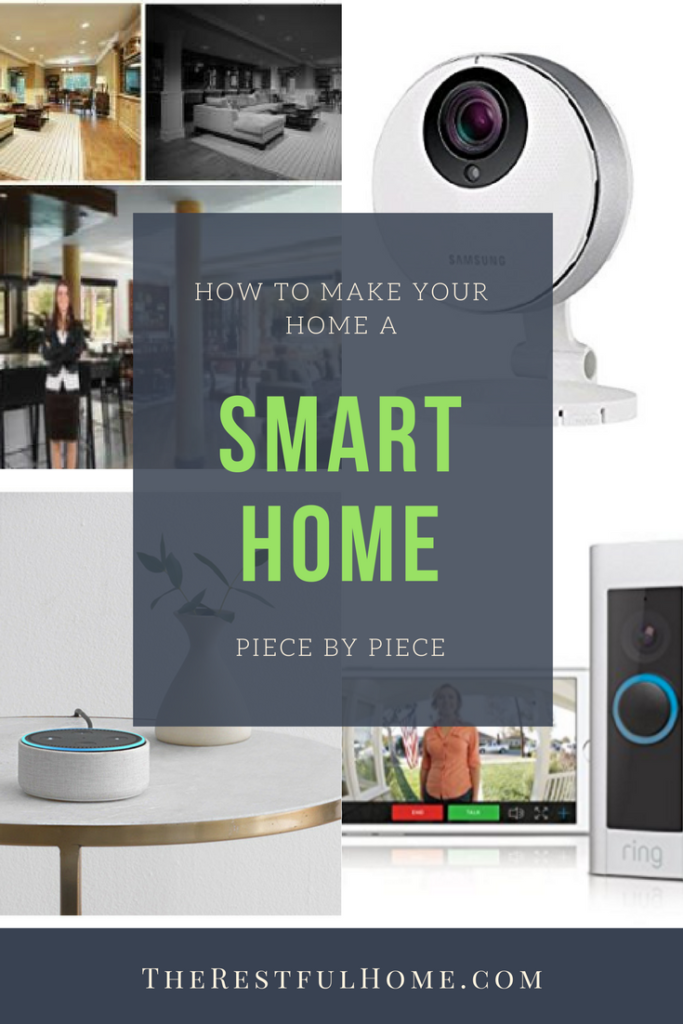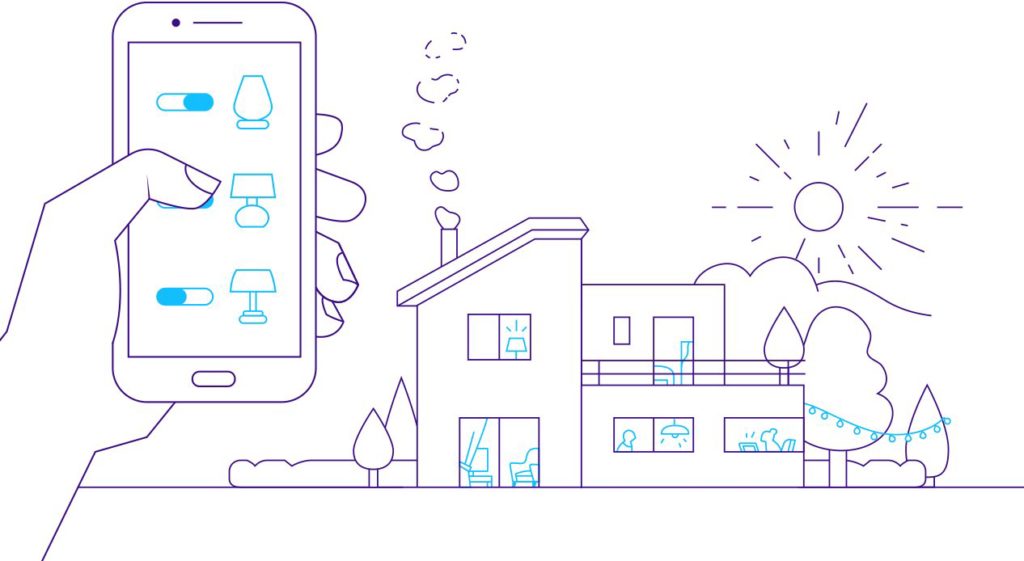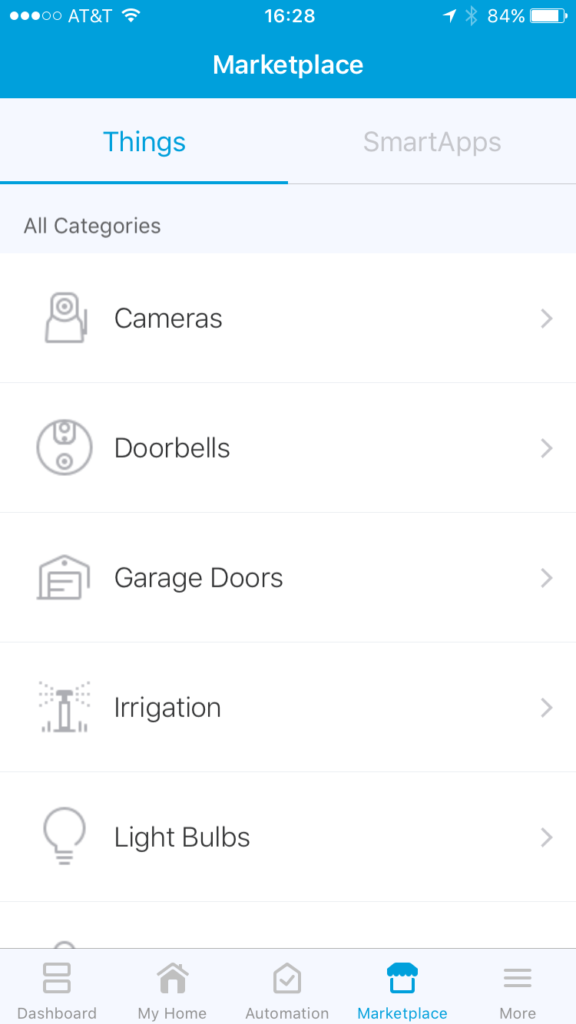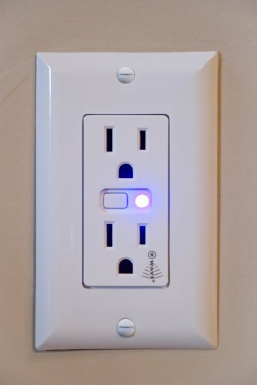 Why make your home a smart home? Because you can monitor your home’s security, keep your home energy-efficient even when you are away, and perform simple tasks without leaving your toddler’s side.
Why make your home a smart home? Because you can monitor your home’s security, keep your home energy-efficient even when you are away, and perform simple tasks without leaving your toddler’s side.
My husband, David, adds that it’s for “ease of use and convenience in your home.” He is all about technology; I am a reluctant semi-convert. I was not a fan of the smart home until we got Amazon Alexa to control things for me, because I didn’t want to have to open an app to turn off my lamp. Seriously! However, he has convinced me that some aspects of a smart home can save us money and time. For example, if I leave the air conditioner running on high when we go out of town, David can reset it to the appropriate temperature (or turn it off). When both of us leave the house, most of our lights turn off if we have programmed them to do so. Those are both energy-saving and cost-efficient effects of having a smart home. (And David is really good about making sure everything is energy-saving–one of the very first things he did when we moved into our house was change all the lights to LED.)
Following is a guest post by David, my resident technical genius, on how to make your home a smart home.
 First Things First
First Things First
When you’re starting a smart home, you need to decide what hub you’re going to use. A hub is something that controls all of your devices–like a master switch. It also communicates via several “languages,” such as ZigBee, Z-Wave, Bluetooth and Wifi. Here are some of your options:
- Samsung SmartThings (this is the one we use. We chose it because at the time we bought it, it was compatible with the most “languages.” In other words, it could communicate with the widest variety of smart devices.)
- Wink / Wink Hub 2
- Iris Smart Hub (this was pretty basic a year ago)
- Apple Smart Home (runs from Apple TV and iPhones–when we started setting up a smart home, it wasn’t compatible with very much)
We have our SmartThings hub in our office, connected via ethernet to our whole-home wifi system. (The Netgear Orbi.) We set up an account with SmartThings and each of us downloaded the smartphone app.
Building a Framework
* Smart Thermostat
I wanted us to be able to control temperatures when we were away. Because I travel frequently for work, this was important. We went with this Honeywell Smart Thermostat because it performed all the functions I wanted and was less expensive than other options on the market. (We also considered the EcoBee/Alexa thermostat, but at the time it was out of our price range.)
* Smart Plugs
Even if your lamp isn’t smart, your outlets can be. Here are several types we’ve tried in our home:
- TP-Link Smart Plug No hub is required for these because they operate on Wifi. If you have a smartphone and wifi, you can use them right away. While they are large and a little inconvenient, if you want to make your lights “smart” so you can turn them on and off remotely without investing in a hub, these are the way to go. (Before we got a hub, we used the Kasa app to control these.)
- Smart Light Switches (for example, we have this dimmer switch for one of our light fixtures because Anna prefers low light in the mornings and evenings)
- SmartThings Outlet (This one doesn’t cover both outlets, which is great, but it requires the Smart Things hub.)
- GE Z-Wave Wireless Smart Outlet These work really well, but require a hub that “speaks” Z-Wave, such as Smart Things. I prefer these outlets because you have a much cleaner installation. Instead of having a blocky piece sticking out and covering both outlets, you have what looks like a modern version of a normal outlet. (Anna also by far prefers these outlets to our other smart plugs.)
Security System
You have the option of using the following pieces as part of a self-monitored security system if you prefer to avoid monthly bills. Or, if you want a monitored system, SmartThings now allows you to do that, too.
- SmartThings Multipurpose Sensor We have multiple sensors in our house. They let us know when doors are opened and closed. They also read the temperature in each of their locations and can tell the thermostat to turn off if a door is left open. (Energy-saving!)
- SmartThings Motion Sensor Senses motion–usually real motion, but occasionally something small will wake it up. Like the other sensors, it provides temperature readings.
- Aeotec Siren by Aeon This is a 105dB siren and is loud enough to wake the dead. (Ask me how I know!)
- Samsung SmartCam HD Pro Live streams 1080p HD. Can record to an SD card. NO SUBSCRIPTION FEE! (We love this last feature! Who wants bills that show up regularly?)
All of the above pieces are easy to install, although I had to try a couple times to get some of the door

Screenshot of Categories of Devices in SmartThings
sensors in the right place. You use the app to connect all the sensors, camera, etc. to the hub. Instructions come with each of the pieces, but here’s a quick rundown of how to do that:
- Follow the instructions that come with your device to prepare it for pairing.
- In the SmartThings app, click on Marketplace.
- Select the category of the device you’re trying to add to your system. (Such as a smart lock or siren.) See the screenshot at right.
- Select your device from the list that will show up of supported devices.
- Select “Connect Now.”
Best Purchase for Smart Home: Alexa
We have the Amazon Echo Dot and love it! Until we had Alexa, Anna was not a fan of our smart home. She’d forget the passwords for the apps or forget how to use the smart plugs. But with Alexa, she can just say, “Alexa, turn on the breakfast nook.” Or, since that light is equipped with the dimmer switch, “Alexa, set breakfast nook to 50%.” (You name the lights/outlets in your home, and it’s important to use only the name you gave the fixture, because Alexa isn’t a good guesser yet!)
We have a speaker (this one by Braven) that we connect with the Echo Dot so Alexa/Amazon’s music sounds good. If you don’t already have a speaker and want a better quality of sound than the Dot offers, you can go up to the Amazon Echo, which has a built-in speaker.
Elements We May Add When We Have the Money
I (David) love the idea of making our home as smart (and energy-efficient) as possible. But our budget doesn’t allow making everything smart at once, so we’ve added just a few pieces at a time. Here are some more pieces we may add once we have room in the budget.
- Netgear Arlo Pro Security Camera System Add more security cameras around the outside of the house.
- RING Video Doorbell A replacement door bell that alerts you on your phone and allows you to see and talk with whoever is at the front door. (There’s a speaker built into the doorbell.) The pro version doesn’t use batteries, which is a plus. This is expensive and would be far-into-the-future.
However, it’s a great burglar deterrent.
- LIFX Smart LED Bulb Energy efficient LED bulbs that can also change color and dim.
- Kwikset Smart Lock So that we can lock/unlock the door remotely and quit hiding keys under the fake dog poop.
- First Alert 2-in-1 Smoke Alarm Smoke detector / carbon monoxide detector that integrates with SmartThings.
To Sum It Up
A smart home isn’t a need, obviously, but it’s definitely convenient and helps us keep our house energy-efficient. It also gives me peace of mind when I’m traveling because I can check in on the house to make sure it’s safe and the AC isn’t running all the time! Budget-friendly it is not (that’s probably part of the reason Anna doesn’t buy steak). But paying every month for a monitored security system or for mistakenly leaving on all the lights and the air conditioner when we leave for vacation wouldn’t be budget-friendly, either.
Thank you for purchasing through our affiliate links! It doesn’t cost you anything extra and it helps us keep our website running!  Read our disclosure policy here.
Read our disclosure policy here.



 : a favorite place to walk when we can!
Once
: a favorite place to walk when we can!
Once 
![The first photos are of my parents’ sprawling rural Arkansas garden. The last is of my tiny little beds in the big city. Plants bring life to even the smallest corner!
I’ve been reading some beautiful fiction this year, and I just posted a review of a book by one of my favorite authors, Leif Enger. (https://therestfulhome.com/brave-young-handsome-review/ in your browser, or click on the link in my Instagram profile) If you don’t have time to read the book, though, here’s just a quote or two for your enjoyment:
🎼
“Death arrived easy as the train; [he] just climbed aboard, like the capable traveler he was.”
🛤️
On riding a horse: “You are a feeble and tenuous being; the only thing a horse wants from you is your absence.” 🐎 😄
#quotes #leifenger #amreading #gardens #gardening](https://scontent-atl3-1.cdninstagram.com/v/t39.30808-6/468657020_18342474787176025_4442629541396867851_n.jpg?_nc_cat=108&ccb=1-7&_nc_sid=18de74&_nc_ohc=DEja6UP2ct4Q7kNvgEYJxCM&_nc_zt=23&_nc_ht=scontent-atl3-1.cdninstagram.com&edm=ANo9K5cEAAAA&_nc_gid=AA4bBsvQ_JpqZXLUPUTpTC8&oh=00_AYCjI9LUx-cJxe6cu0n7H1Gounaz92aBlTrQacnKut8umg&oe=67567CAB)

















[…] seen the movie Ratatouille, since he’s just 10 months old, but he loves the music. (And our smart home allows us to play it any time–I just have to ask Alexa!) Another movie with a beautiful […]